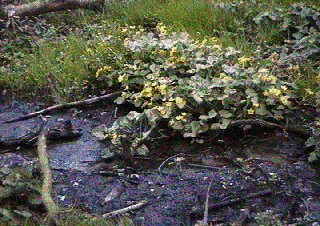The wind continued to blow from the northeast this evening, so I decided to go back to the sett across the river in Quesse Wood, where I could watch from the other side of the valley with the wind taking my scent directly away from the sett. A sheet of grey cloud hid the sky, but as I walked down the track to the river, there was a clear red slot along the horizon before me where the sun would show briefly when it set.
A heron was hunched on the river bank hoping that I would not see him. When I lifted my binoculars, he stretched his neck in resignation and flapped off heavily downriver. A bit further along were the three male mallards who had been pestering a female for the last few weeks. They took to the water as I came opposite them and swam away. No sign of the female – perhaps she was sitting on eggs somewhere.
 As I crossed the water meadow towards the wood at the mouth of the valley, I could see the powdery blue mist lying under the trees. By the time I was crossing the barbed wire fence, it had resolved into the individual bluebell flowers which make the wood spectacularly beautiful in Spring. As I walked across the mouth of the valley, a mass of golden Marsh Marigolds beside a boggy pool caught my eye, and then I climbed the slope on the far side through several patches of wood anemone.
As I crossed the water meadow towards the wood at the mouth of the valley, I could see the powdery blue mist lying under the trees. By the time I was crossing the barbed wire fence, it had resolved into the individual bluebell flowers which make the wood spectacularly beautiful in Spring. As I walked across the mouth of the valley, a mass of golden Marsh Marigolds beside a boggy pool caught my eye, and then I climbed the slope on the far side through several patches of wood anemone.
When I came level with the badger sett, I chose a tree to rest against from where I could see the hole from which the badgers emerged a couple of weeks ago. After 10 minutes, a black and white face appeared above the mound in front of the hole and sampled the air with characteristic jerky movements. A second badger appeared beside the first, but both were extremely cautious and went back down again after a few minutes. For the next half an hour, I listened to the bird song and watched the pigeons flying from tree to tree as the light faded. Why don’t they settle in the first tree they land in? Why don’t they fly straight to the tree they will settle in? In half an hour of looking and listening in a wood at dusk, it is surprising how many questions come to mind, and it is good that sometimes some answers arrive as well.
At five to nine, the badgers came back up. I was on the same level as the hole, and could only see the top half of their bodies as they scratched and groomed each other at the sett entrance, still showing extreme caution. After a while, one left along a path leading up the valley while the other two were joined by a fourth. After a while, closely watching what I could see of the three on the mound, I had the idea that one was an adult female while the other two were definitely smaller and were probably her cubs from last year. Just as I came to this conclusion, she came out on to the path beside the mound of earth outside the hole, sat down on her backside and groomed her tummy with great concentration. I could then clearly see that she was in milk – as I had thought, there were cubs below ground, but they must have been born late if they were still not ready to emerge.
After a while, I could hear a steady swish, swish down in the valley, and the badgers on the mound anxiously peered down at the noise. I thought at first that the badger which had left was returning with bedding (dry grass and leaves), but then in the half light I saw him coming up the bank towards me. Staying motionless, I watched as he browsed along the woodland floor, looking for worms and beetles. He passed me by within a couple of yards, and did not return. He must have turned right at the top of the slope, otherwise he would have caught my scent and hurtled back to the sett.
As it got darker, two badgers left the sett towards the mouth of the valley, but one remained – I expect that it was the female but it was too dark to be sure. When they were out of sight, I left and made my way back to the village in the dark.